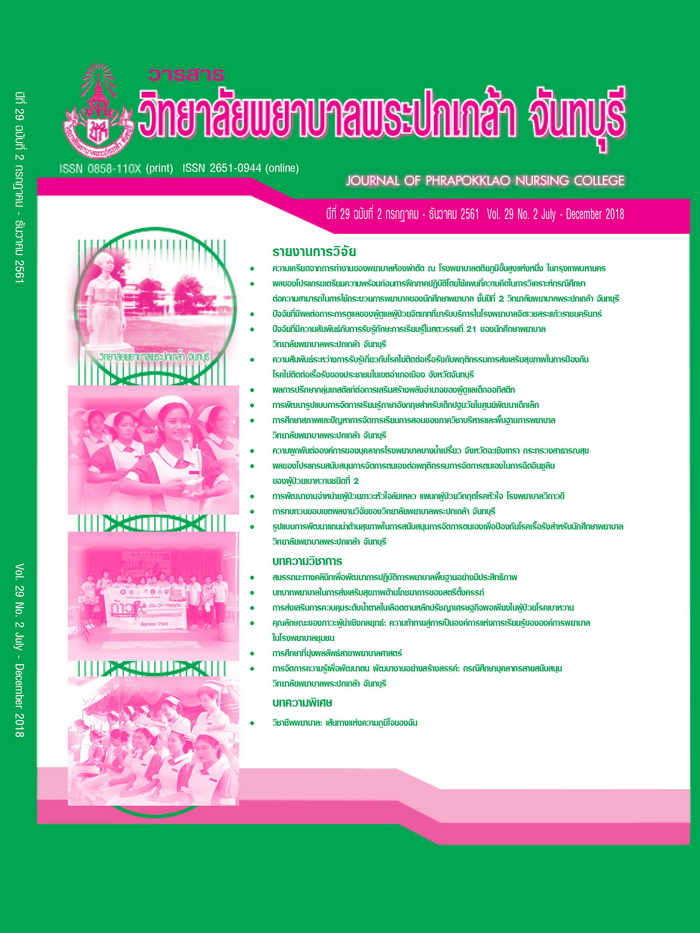Promoting Glycemic Control through the Philosophy of Sufficiency Economy among Patients with Diabetes Mellitus
Keywords:
Glycemic control, Philosophy of sufficiency economy, Diabetes mellitusAbstract
Diabetes mellitus is a chronic and non-communicable disease. It occurs most frequently in adults, older adults, and pregnants. All types of diabetes have something in similar. High concentrations of blood glucose turn damage many of the body’s systems, and induce to complex complication and mortality. Appropriated blood glucose control is very important method to reduce risks of complication. Health care supporting according to the “philosophy of sufficiency economy” can serve good health care outcomes for diabetic patients. “Sufficiency” means moderation, reasonableness, and the need of self-immunity for sufficient protection. An application of knowledge with consideration and moral is essential. In the utilization of concepts and principles, it is needed for appropriated planning and implementation in every step regarding knowledge of diabetes, perceived severity and impact from diabetes, and perceived benefit in diabetic treatment and lifestyle modification on diet, exercise, and so on. However, good collaboration among the patients, families, and health care teams is an important factor that can conduce to the effective glycemic control through the philosophy of sufficiency economy.
References
กรกต วีรเธียร อินทร์เอื้อ. (2553). โภชนบำบัด. ใน สมเกียรติ โพธิสัตย์, วรรณี นิธิยานันท์, อัมพา สุทธิจำรูญ, และยุพิน เบ็ญจสุรัตน์วงศ์. (บ.ก.), การให้ความรู้เพื่อจัดการโรคเบาหวานด้วยตนเอง (น. 35-55). กรุงเทพฯ: โรงพิมพ์ชุมนุมสหกรณ์การเกษตรแห่งประเทศไทย.
กาญจนา ศรีสวัสดิ์, และอรพินท์ สีขาว. (2557). การดูแลหญิงที่เป็นโรคเบาหวานขณะตั้งครรภ์. วารสารพยาบาลทหารบก, 15(2), 50-59. สืบค้นจาก https://www.tci-thaijo.org/index.php/JRTAN/article/view/25156/21418
เครือข่ายวิจัยกลุ่มสถาบันแพทยศาสตร์แห่งประเทศไทย. (2555). การประเมินผลการดูแลผู้ป่วยโรคเบาหวานชนิดที่ 2 และความดันโลหิตสูงของโรงพยาบาลในสังกัดกระทรวงสาธารณสุขและโรงพยาบาลในสังกัดกรุงเทพมหานคร ประจำปี 2555 (รายงานผลการวิจัย). กรุงเทพฯ: สำนักงานหลักประกันสุขภาพแห่งชาติ. สืบค้นจาก http://www.tima.or.th/index.php/component/attachments/download/24
ธันวา จิตต์สงวน. (2560). เอกสารประกอบการสอนเรื่องการพัฒนาที่ยั่งยืนและปรัชญาเศรษฐกิจพอเพียง. กรุงเทพฯ: คณะเศรษฐศาสตร์ มหาวิทยาลัยเกษตรศาสตร์.
ธัสมน นามวงษ์, รัชชนก สิทธิเวช, และสุมาลี ราชนิยม. (2560). ผลของโปรแกรมสนับสนุนการจัดการตนเองต่อพฤติกรรมการจัดการตนเองในการฉีดอินซูลินของผู้ป่วยเบาหวานชนิดที่ 2 (รายงานผลการวิจัย). วิทยาลัยพยาบาลพระปกเกล้า จันทบุรี.
นงณภัทร รุ่งเนย, ศิริพร ครุฑกาศ, เยาวลักษณ์ มีบุญมาก, นงคราญ บุญอิ้ง, และน้ำฝน วชิรรัตนพงษ์เมธี. (2560). การอธิบายความเจ็บป่วยของผู้สูงอายุโรคเบาหวานชนิดที่ 2. ราชาวดีสาร วิทยาลัยพยาบาลบรมราชชนนี สุรินทร์, 7(1), 20-30.
ปรียานุช พิบูลสราวุธ. (2551). ปรัชญาของเศรษฐกิจพอเพียง (Sufficiency economy) กับการประยุกต์ใช้. สืบค้นจาก http://www.cse.nida.ac.th/main/images/pdf/1.pdf.org
พรทิพย์ สมตัว, ปาหนัน พิชยภิญโญ, วีณา เที่ยงธรรม, และดุสิต สุจิรารัตน์. (2559). ปัจจัยทำนายพฤติกรรมการรับประทานอาหารของผู้ป่วยโรคเบาหวานชนิดที่ 2. วารสารพยาบาลสาธารณสุข, 30(1), 1-12. สืบค้นจาก http://phpn.ph.mahidol.ac.th/Journal/txt/30_no1/f1porntip.pdf
พรธรรมรส โพธิ, จรัสศรี ธีระกุลชัย, จันทิมา ขนบดี, และพัญญู พันธ์บูรณะ. (2559). ผลของโปรแกรมการออกกำลังกายโดยใช้แรงต้านต่อการควบคุมระดับน้ำตาลในเลือดของสตรีตั้งครรภ์ที่เป็นเบาหวานชนิด เอ วัน. วชิรสารการพยาบาล, 18(2), 12-24. สืบค้นจาก https://www.tci-thaijo.org/index.php/vnj/article/view/139180/103359
ลัฆวี ปิยะบัณฑิตกุล. (2559). การสร้างนโยบายสาธารณะเพื่อสุขภาพแบบมีส่วนร่วม การปรับระบบบริการสุขภาพ และการสร้างสิ่งแวดล้อมที่เอื้อต่อสุขภาพ. นนทบุรี: มาตาการพิมพ์.
วิษณุกร นาชัยดูลย์. (2559). การปรับเปลี่ยนพฤติกรรมของผู้ป่วยเบาหวานชนิดไม่พึ่งอินซูลิน ในเขตรับผิดชอบโรงพยาบาลส่งเสริมสุขภาพตำบลหนองแต้น้อย อำเภอนาตูม จังหวัดมหาสารคาม (วิทยานิพนธ์ปริญญามหาบัณฑิต). มหาวิทยาลัยมหาสารคาม.
สมพร กันทรดุษฎี-เตรียมชัยศรี. (ม.ป.ป.). การสร้างเสริมสุขภาพด้วยสมาธิบำบัด SKT 1-7. สืบค้นจาก http://www.thaicam.go.th
สมาคมโรคเบาหวานแห่งประเทศไทย. (2560). แนวทางเวชปฏิบัติสำหรับโรคเบาหวาน 2560. ปทุมธานี: ร่มเย็น มีเดีย.
สายฝน ม่วงคุ้ม. (2559). รูปแบบการจัดการตนเองในการชะลอภาวะแทรกซ้อนของผู้ป่วยเป็นเบาหวานชนิดที่ 2 เขตภาคตะวันออกของประเทศไทย (รายงานผลการวิจัย). ชลบุรี: มหาวิทยาลัยบูรพา.
สำนักงานพัฒนานโยบายสุขภาพระหว่างประเทศ. (2560). รายงานภาระโรคและการบาดเจ็บของประชากรไทย พ.ศ. 2557. สืบค้นจาก http://library.thaihealth.or.th/ULIB/dublin.php?ID=9011#.WZ01rj5JbIU
สำนักนโยบายและยุทธศาสตร์. (2558). จำนวนและอัตราผู้ป่วยในด้วยโรคเบาหวาน (E10-E14) ต่อประชากร 100,000 คน พ.ศ. 2550-2557. สืบค้นจาก http://bps.moph.go.th
สีไพร พลอยทรัพย์, ทัศนีเวศ ยะโส, และฐิตินันท์ อินทอง. (2558). แนวทางการดูแลผู้ป่วยเบาหวานด้วยการแพทย์ผสมผสาน. สืบค้นจาก http://www.thaicam.go.th/index.php?option=com_attachments&task=download&id=1066
สุพัชรี ใจแน่, และศิริพันธุ์ สาสัตย์. (2559). ปัจจัยทำนายภาวะน้ำตาลในเลือดต่ำของผู้สูงอายุโรคเบาหวานที่เข้ารับการรักษาในโรงพยาบาลในเขตภาคใต้ตอนบน. วารสารเกื้อการุณย์, 23(1), 148-162. สืบค้นจาก http://www.kcn.ac.th/KCN-Journal/Journal/12559/Job%2020160630_10.pdf
อภิญญา เมืองคำ, และศิริตรี สุทธจิตต์. (2556). ผลของการเสริมสร้างศักยภาพผู้ป่วยโรคเบาหวานชนิดที่ 2 ต่อการรับรู้ความสามารถของตนเอง ความร่วมมือในการรักษา และการควบคุมระดับน้ำตาลในเลือด. วารสารไทยเภสัชศาสตร์และวิทยาการสุขภาพ, 8(3), 104-111. สืบค้นจาก http://ejournals.swu.ac.th/index.php/pharm/article/view/3929
American Diabetes Association. (2018). Management of diabetes in pregnancy: Standards of medical care in diabetes-2018. Diabetes Care, 41(Suppl. 1), 137-143.
Diabetes UK. (2017). How can I reduce my risk of type 2 diabetes?. Retrieved from http://www.diabetes.org.uk
International Diabetes Federation. (2017). World Diabetes Day 2017: Women and Diabetes. Diabetes Voice Online, 64(4), 9-13. Retrieved from https://www.idf.org/component/attachments/attachments.html?id=1471&task=download
Johansen, M. Y. (2017). Effect of an intensive lifestyle intervention on glycemic control in patients with type 2 diabetes. JAMA, 318(7), 637-646.
World Health Organization. (2012). Guideline: Sodium intake for adults and children. Geneva: Author.
Downloads
Published
How to Cite
Issue
Section
License
Copyright (c) 2018 JOURNAL OF PHRAPOKKLAO NURSING COLLEGE

This work is licensed under a Creative Commons Attribution-NonCommercial-NoDerivatives 4.0 International License.
เนื้อความ ข้อมูล และรายการอ้างอิงที่ผู้เขียนใช้ในการเขียนบทความเพื่อลงตีพิมพ์ในวารสารวิทยาลัยพยาบาลพระปกเกล้า จันทบุรี ถือเป็นความคิดเห็นและความรับผิดชอบของผู้เขียน คณะผู้จัดทำวารสารไม่จำเป็นต้องเห็นพ้องด้วยหรือร่วมรับผิดชอบ
บทความที่ได้รับการลงตีพิมพ์ในวารสารวิทยาลัยพยาบาลพระปกเกล้า จันทบุรี ถือเป็นลิขสิทธิ์ของวารสารวิทยาลัยพยาบาลพระปกเกล้า จันทบุรี หากหน่วยงานหรือบุคคลใดต้องการนำส่วนหนึ่งหรือทั้งหมดของบทความไปเผยแพร่ต่อเพื่อวัตถุประสงค์ใด ๆ จะต้องได้รับอนุญาตจากบรรณาธิการวารสารก่อน



